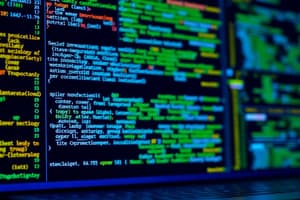Podcast
Questions and Answers
What is the primary use of R programming language?
What is the primary use of R programming language?
- Statistical computing and data analysis (correct)
- Game development
- Graphic design
- Web development
Which of the following libraries is NOT commonly used in R for data manipulation?
Which of the following libraries is NOT commonly used in R for data manipulation?
- tidyverse
- ggplot2
- dplyr
- numpy (correct)
What will the following R code print? print("Hello, R!")
What will the following R code print? print("Hello, R!")
- Hello, R! (correct)
- Hello, World!
- R!
- Prints an error
Which arithmetic operation does R NOT directly support?
Which arithmetic operation does R NOT directly support?
To install the 'dplyr' library in R, which command is used?
To install the 'dplyr' library in R, which command is used?
Which of the following statements about R programming is correct?
Which of the following statements about R programming is correct?
The 'ggplot2' library is used for statistical computing in R.
The 'ggplot2' library is used for statistical computing in R.
What command is used to load a library in R after it has been installed?
What command is used to load a library in R after it has been installed?
In R, the function used to install a package is install.packages("______".
In R, the function used to install a package is install.packages("______".
Match the following R operations with their descriptions:
Match the following R operations with their descriptions:
Study Notes
R Fundamentals
- R is a programming language designed for statistical computing and data analysis.
- It offers numerous libraries and functions to manage extensive datasets efficiently.
- Basic syntax example to print text:
print("Hello, R!")
Installing and Using Libraries
- Common libraries in R include:
dplyrfor data manipulationggplot2for data visualizationtidyversefor a collection of R packages that work togethercaretfor machine learning tasks
- Example of installing and loading a library:
install.packages("dplyr") library(dplyr)
Basic Mathematical and Logical Operations
- R supports fundamental arithmetic operations: addition, subtraction, multiplication, and division.
R Fundamentals
- R is a programming language designed for statistical computing and data analysis.
- It offers numerous libraries and functions to manage extensive datasets efficiently.
- Basic syntax example to print text:
print("Hello, R!")
Installing and Using Libraries
- Common libraries in R include:
dplyrfor data manipulationggplot2for data visualizationtidyversefor a collection of R packages that work togethercaretfor machine learning tasks
- Example of installing and loading a library:
install.packages("dplyr") library(dplyr)
Basic Mathematical and Logical Operations
- R supports fundamental arithmetic operations: addition, subtraction, multiplication, and division.
Studying That Suits You
Use AI to generate personalized quizzes and flashcards to suit your learning preferences.
Description
This quiz covers the fundamentals of R programming, including its basic concepts and the use of libraries for data analysis. Participants will learn about key libraries essential for data manipulation and visualization tasks in R. Test your understanding of R's capabilities and installation processes.




